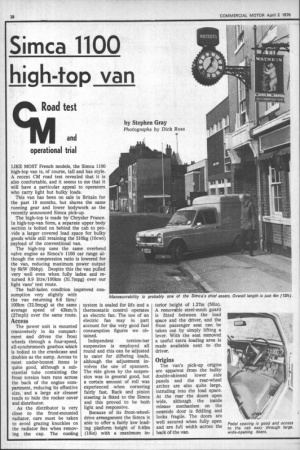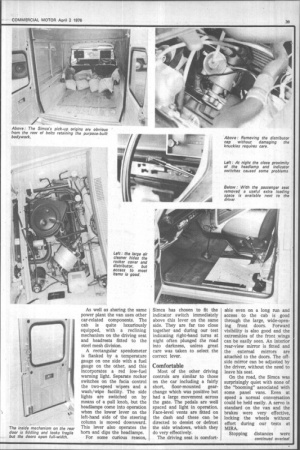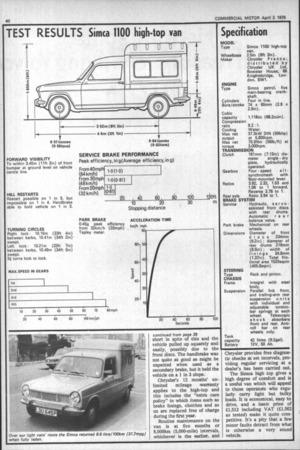Simca 1100 high-top van
Page 40

Page 41

Page 42

If you've noticed an error in this article please click here to report it so we can fix it.
and operational trial
LIKE MOST French models, the Simca 1100 high-top van is, of course, tall and has style. A recent CM road test revealed that it is also comfortable, and it seems to me that it will have a particular appeal to operators who carry light but bulky loads.
This van has been on sale in Britain for the past 18 months, but shares the same running gear and lower bodywork as the recently announced Simca pick-up.
The high-top is made by Chrysler France. In high-top-van form, a separate upper body section is bolted on behind the cab to provide a larger covered load space for bulky goods while still retaining the 510kg (10cwt) payload of the conventional van.
The high-top uses the same overhead valve engine as Simca's 1100 car range although the compression ratio is lowered for the van, reducing maximum power output by 6kW (8bhp). Despite this the van pulled very well even when fully laden and returned 8.9 litre/1001cm (31.7rnpg) over our light vans' test route.
con the van returning 8.6 litre/ 100km (32.5mpg) at the same average speed of 43km/h (27mph) over the same route.
Access
The power unit is mounted transversely in Its 'compartment and drives the front wheels through a four-speed, all-synchromesh gearbox which is bolted to the crankcase and doubles as the sump. Access to most under-bonnet items is quite good, although a substantial tube containing the front torsion 'bars runs across the back of the engine compartment, reducing its effective size, and a large air cleaner tends to hide the rocker cover and distributor.
As the distributor is very close to the front-mounted radiator, care must be taken to avoid grazing knuckles on the radiator fins when removing the cap. The cooling system is sealed for life and a thermostatic control operates an electric fan. The use of an electric fan may in part account for the very good fuel consumption figures we obtained.
Independent torsion-bar suspension is employed all round and this can be adjusted to cater for differing loads, although the adjustment Involves the use of spanners. The ride given by the suspension was in general good, but a certain amount of roll was experienced when cornering fairly fast. Rack and pinion steering is fitted to the Simca and this proved to be both light and responsive.
Because of its front-wheeldrive arrangement the Simca is able to offer a fairly low loading platform height of 0.45m (18in) with a maximum
in
tenor height of 1.27m (50in). A removable steel-mesh guard is fitted between the load space and the driver, and the front passenger seat can be taken out by simply lifting a lever. With the seat removed a useful extra loading area is made available next to the driver.
Origins
The van's pick-up origins are apparent :from the bulky double-skinned lower side panels and the rear-wheel arches are also quite large, intruding into the load space. At the rear the doors open wide, although the inside release mechanism on the nearside door is fiddling and looks fragile. The dears are well secured when fully open and are full width across the back of the van. As well as sharing the same power plant the van uses other car-related components. The cab is quite luxuriously equipped, with a reclining mechanism on the driving seat and headrests fitted to the steel mesh division.
A rectangular speedometer is flanked by a temperature gauge on one side with a fuel gauge on the other, and this incorporates a red low-fuel warning light. Separate rocker switches on the facia control the two-speed wipers and a wash/wipe facility. The side lights are switched on by means of a pull knob, but the headlamps come into operation when the lower lever on the left-hand side of the steering column is moved downward. This lever also operates the horn and dips the headlamps.
For some curious reason, Simca has chosen to fit the indicator switch immediately above this lever on the same side. They are far too close together and during our test indicating right-hand turns at night often plunged the road into darkness, unless great care was taken to select the correct lever.
Comfortable
Most of the other driving controls are similar to those on the car including a fairly short, floor-mounted gearchange which was positive but had a large movement across the gate. The pedals are well spaced and light in operation. Face-level vents are fitted on the dash and these can be directed to demist or defrost the side windows, which they do very effectively.
The driving seat is comfort able even on a long run and access to the cab is good through the large, wide-opening front doors. Forward visibility is also good and the extremities of the front wings can be easily seen. An interior rear-view mirror is fitted and the external mirrors are attached to the doors. The offside mirror can be adjusted by the driver, without the need to leave his seat.
On the road, the Simca was surprisingly quiet with none of the "booming" associated with some panel vans. Even at speed a normal conversation could be held easily. A servo is standard on the van and the brakes were very effective, locking the wheels without effort during our tests at MIRA.
Stopping distances were short in spite of this and the vehicle pulled up squarely and easily, possibly due to the front discs. The handbrake was not quite as goad as might be expected when used as a secondary brake, but it held the vehicle on a 1 in 3 slope.
Chrysler's 12 months' unlimited mileage warranty applies to the high-top and this includes the "extra care policy" in which items such as brake linings, clutches and so on are replaced free of charge during the first year.
Routine maintenance on the van is at five months or 8,000km (5,000-mile) intervals, whichever is the earlier, and Chrysler provides free diagnostic checks at set 'intervals, providing regular servicing at a dealer's has been carried out.
The Simca high top gives a high degree of comfort and is a useful van which will appeal to those operators who regularly carry light but bulky loads. It is economical, easy to drive, and a basic price of £1,512 including VAT (£1,562 as tested) make it quite competitive. It's a pity that a few minor faults detract from what is otherwise a very sound vehicle.




























































































